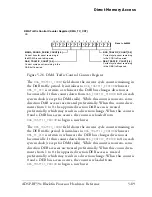
Programming Examples
5-100
ADSP-BF59x Blackfin Processor Hardware Reference
r0.l = 1;
w[p1] = r0;
/* start with balanced request counter */
p1.l = lo(HMDMA1_ECINIT);
r0.l = 0;
w[p1] = r0;
/* enable for rising edges */
p1.l = lo(HMDMA1_CONTROL);
r2.l = REP | HMDMAEN;
w[p1] = r2;
If the HMDMA is intended to copy from internal memory to external
devices, the above setup is sufficient. If, however, the data flow is from
outside the processor to internal memory, then this small issue must be
considered—the HMDMA only controls the destination channel of the
memory DMA. It does not gate requests to the source channel at all.
Thus, as soon as the source channel is enabled, it starts filling the DMA
FIFO immediately. In 16-bit DMA mode, this results in eight read strobes
on the EBIU even before the first DMAR1 event has been detected. In
other words, the transferred data and the DMAR1 strobes are eight posi-
tions off. The example in
Listing 5-9
delays processing until eight
DMAR1 requests have been received. By doing so, the transmitter is
required to add eight trailing dummy writes after all data words have been
sent. This is because the transmit channel still has to drain the DMA
FIFO.
Listing 5-9. HMDMA With Delayed Processing
/* wait for eight requests */
p1.l = lo(HMDMA1_ECOUNT);
r0 = 7 (z);
initial_requests:
r1 = w[p1] (z);
Summary of Contents for ADSP-BF59x Blackfin
Page 64: ...Development Tools 1 22 ADSP BF59x Blackfin Processor Hardware Reference...
Page 74: ...Processor Specific MMRs 2 10 ADSP BF59x Blackfin Processor Hardware Reference...
Page 244: ...Programming Examples 6 40 ADSP BF59x Blackfin Processor Hardware Reference...
Page 700: ...Programming Examples 16 78 ADSP BF59x Blackfin Processor Hardware Reference...
Page 738: ...Boundary Scan Architecture B 8 ADSP BF59x Blackfin Processor Hardware Reference...
















































